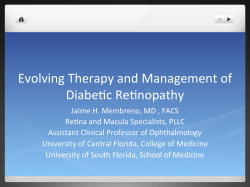
Diabetic eye disease is the leading cause of blindness among... developed countries
Diabetic retinopathy: What is the cause? Diabetic eye disease is the leading cause of blindness among working-age adults in developed countries1: macular oedema and proliferative diabetic retinopathy (DR) are the main causes of vision loss2, 3. In order to find appropriate treatments for these diseases, an understanding of the underlying mechanisms is required. Comprehension of these mechanisms is constantly evolving. A cascade of events instigated by hyperglycaemia Hyperglycaemia Oxidative stress AGE PKC activation Inflammation Sorbitol RAS Vascular endothelial dysfunction Retinal ischaemia CA Hypertension Vascular permeability Diabetic macular oedema Retinal neovascularisation PDR complications (VH/RD) VEGF GH-IGF Erythropoietin AGE=advanced glycation-end products. CA=carbonic anhydrase. GH=growth factor. IGF=Insulin growth factor. PDR=proliferative diabetic retinopathy. PKC=protein kinase C. RAS=renin agiotensin system. RD=retinal detachment. VEGF=vascular endothelial growth factor. VH=vitreous haemorrhage. Diabetic retinopathy: What is the cause? The basic problem with the pathophysiology and pathogenesis of diabetic retinopathy is that there is not one clear pathway that leads to vascular damage. A number of metabolic pathways are disturbed by hyperglycaemia which is believed to initiate a cascade of biological and physiological changes leading to retinal endothelial dysfunction. Implicated pathways involve the production and accumulation of advanced glycation end-products (AGE), which involves protein degradation and dysfunction in the retinal vasculature, and activation of protein kinase C (PKC) synthesis. Low-grade inflammation has been advocated as a possible mechanism, as has sorbitol accumulation. Increased glucose in the polyol pathway as a result of hyperglycaemia is converted into intracellular sorbitol, possibly inducing osmotic damage to endothelial cells and pericytes. It has been hypothesized that the possible common denominator (‘unifying mechanism’) of these biochemical pathways is high-glucose-induced excess production of reactive oxygen species (ROS).5 Oxidative stress plays a pivotal role in the development of diabetes complications, both microvascular and cardiovascular.6 Permeability and ischemia In parallel, activation of the renin–angiotensin system (RAS) particularly within the eye may be involved. Intraocular RAS can be up-regulated in diabetes, and angiotensin II might stimulate vascular endothelial growth factor (VEGF) expression in retinal vascular endothelial cells. Abnormal endothelial function causes occlusion of capillaries leading to vascular permeability on the one hand, with leakage of fluids from the vascular lumen into the retinal tissues, and localised retinal ischemia on the other.4 Diabetic retinopathy: What is the cause? Permeability and ischaemia Increased permeability is caused by the breakdown of the endothelial-cell–pericyte interaction. The first vascular lesions that occur in the retina are thickening of the basement membrane, endothelial injury, disruption of the tight junctions and pericyte apoptosis. Pericytes surround endothelial cells in the wall of capillaries. Retinal capillaries do not have smooth muscle cells as do aterioles, so pericytes probably participate in regulating blood flow and probably control endothelial cell proliferation too. Pericytes dropout may thus result in the loss of autoregulation ultimately causing the first abnormalities detected in clinical examination by fundoscopy.7 Retinal ischaemia leads to increases in insulin-like growth factor (IGF-1) and growth hormone (GH) which modulate the function of retinal endothelial precursor cells and drive angiogenesis, and VEGF which stimulates neovascularisation in order to reestablish blood flow into the retina and increases capillary permeability. IGF-1 can also disrupt the blood–retina barrier and increase permeability. Left untreated, neovascularisation leads to haemorrhage, retinal traction and retinal detachment, rubeosis iridis and complete loss of visual function and sight.4 Diabetic retinopathy: What is the cause? References 1. Hemmingsen B, Lund SS, Gluud C, et al. Intensive glycaemic control for patients with type 2 diabetes: systematic review with meta-analysis and trial sequential analysis of randomised clinical trials. BMJ 2011;343:d6898. 2. Chew EY, Ambrosius WT, Davis MD, et al. Effects of medical therapies on retinopathy progression in type 2 diabetes. N Engl J Med 2010;363:233-44. 3. Knudsen LL, Lervang HH, Lundbye-Christensen S, Gorst-Rasmussen A. The North Jutland County Diabetic Retinopathy Study: population characteristics. Br J Ophthalmol 2006;90:1404-9. 4. Cheung N, Mitchell P, Wong TY. Diabetic retinopathy. Lancet 2010;376:124-36 5. Brownlee M. Biochemistry and molecular cell biology of diabetic complications. Nature 2001;414:813-20. 6. Giacco F, Brownlee M. Oxidative stress and diabetic complications. Circ Res 2010;107:1058-70. 7. Willard AL, Herman IM. Vascular complications and diabetes: current therapies and future challenges. J Ophthalmol 2012;2012:209538.
© Copyright 2025





















